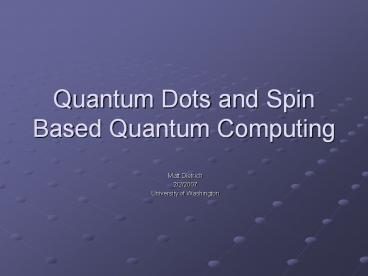Quantum Dots and Spin Based Quantum Computing PowerPoint PPT Presentation
Title: Quantum Dots and Spin Based Quantum Computing
1
Quantum Dots and Spin Based Quantum Computing
- Matt Dietrich
- 2/2/2007
- University of Washington
2
Electrostatic Traps
- Say we want to trap an electron
- Everyone knows you cant make an electrostatic
trap. Laplaces equation prevents it
3
Solutions
- First involves oscillating sign of charges
- Or else just restrict electron to 2D!
- Surely there is no such structure in nature
4
2DEG
- 2 Dimensional Electron Gas (2DEG)
- By growing a thin Si layer on top of a SiGe
substrate, one can make a 2D quantum well - The Ge strains the lattice, destroying the usual
6 fold degeneracy, so that vertical states have
lower energy than horizontal ones.
5
Making a Quantum Dot
Top-gates
Etching
6
Quantum Dots and Spin
- Because individual quantum states are accessible
in a quantum dot, we can trap individual
elections - The number of electrons can be controlled with
bias electrodes - The spin of each electron is available to us
- Spin is hard to measure measure charge instead
7
Two Proposals
- The classic proposal by Loss and DiVincenzo
involves using individual electron spins. - Another proposal by Levy calls on using a two
spin system. The 01gt_p state is 0gt_L, and
10gt_p is 1gt_L.
8
Single Qubit Rotations LD
- AC magnetic fields can cause spin flips
- Electrons can be transported to a high-g
substrate where the magnetic interaction is
stronger
9
Entanglement LD
- Spin-Spin Exchange Interaction
Although 11gt and 00gt are unaffected by this
perturbation, 10gt and 01gt are not eigenstates.
These states are rotated. After a time
pihbar/2J, we have performed half of a swap
operation. This is a known universal quantum gate
J is increased by decreasing the potential
barrier separating the dots
10
Single Qubit Rotations Levy
- The two qubit rotation in LD becomes a one qubit
x rotation for Levy! But 01gt_p10gt_p is not
rotated - If the two QDs have different values of g, a
magnetic field will cause a splitting between the
up state of the first QD and the second. This
allows z rotations, and so together with the
first arbitrary one qubit rotations.
11
Entanglement Levy
- Place two qubits side by side, so that the center
two are coupled - This coupling is sufficient to generate a nAND or
cNOT gate
12
Readout
- With Zeeman splitting and P bias, Kouwenhoven at
Delft can make only the spin up state have EgtE_f
13
Decoherence
- T_1 is the relaxation time time scale it takes
an up spin to swap to a down spin due to
interaction to nuclear magnetic moments. gt1ms - T_2 is the coherence time time scale a quantum
superposition survives. T_2ltltT_1 frequently.
.1-1ms in Si, because the dominant Si isotope has
spin 0
14
Scalability
- Its easy to build many quantum dots
- Characterizing each
- How do you entangle distant QDs? Kondo effect and
RKKY?
15
Bibliography
- Engel et al., Controlling Spin Qubits in Quantum
Dots, Experimental Aspects of Quantum Computing - Eriksson et al., Spin-Based Quantum Dot Quantum
Computing in Silicon, Experimental Aspects of
Quantum Computing - Levy, PRL 89(14) 147902 (2002)
- Fitzgerald, New All-Electrical Measurement
Schemes Can Detect the Spin State of a Single
Electron, Physics Today, October 2004 - Reed, Quantum Dots, Scientific American January
1993 - Loss and DiVincenzo, PRA 57(1) 120 (1998)
- Kouwenhoven and Glazman, Revival of the Kondo
Effect, Physics World January 2001

